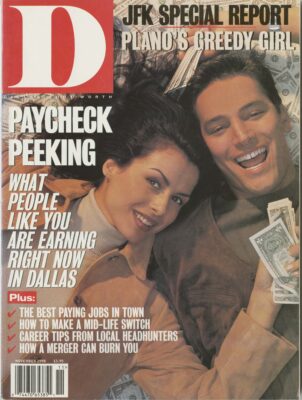SUBSCRIBERS RECEIVE A BONUS THIS month: our third edition of Business Dallas. I’m very proud of the editorial gains this little magazine is making edition-by-edition, and I believe that over the coming year it wilt establish itself as the bible of business journalism in this region, (Newsstand buyers, we love you. But BUSINESS DALLAS only goes to subscribers. The good news is that it’s free with your paid subscription to D Magazine.)
This month’s cover story is a fascinating and, for me, highly instructive interview by editor Richard Urban with automotive legend-in-the-making Carl Sewell on how to build a company. At a luncheon last month with several CEOs, I asked people around the table to introduce themselves and say what they do. When Carl’s turn came, he identified himself as a “used-car salesman.” I’ve heard Sewell use that line for 24 years (he was one of the investors in the original D Magazine back then, so I know him well). Sewell started on his father’s lot selling used cars, and I suspect he uses that line as much to remind himself of his beginnings as to get a laugh. In truth, Sewell is a skilled business strategist and author of Customers for Life, one of the business book genre’s best-selling titles. To my mind, Sewell is one of that rare breed that Jacques Barzun had in mind when he said that “the true intellectuals carry a briefcase.” His eight rules on how to make a company achieve its highest potential apply as aptly to a small business (such as your favorite city magazine) as they do to his own $500 million company. As a matter of fact, those rules are what made his a $500 million company.
While the Sewell piece contains great advice for anyone interested in business, Bob Dietz’s article on local banking in the same issue contains hard facts that present as much of a challenge as they do an incredible opportunity. Dietz reports that Dallas-Fort Worth created 50,000 jobs in the six months ending in June and is on track to generate another 50,000 jobs by the end of December. Most analysts project that next year will produce another 100,000 jobs. Contrast that with, say. New York, where last month ’s announcement by Citibank that its merger with Traveler’s might cost the city 1,400 jobs made the front page of the New York Times. In Dallas, Deitz notes, the same news probably would not amount to more than a small item on the inside pages of the business section. For example, in theorthwestern sector, as I learned recently from Denton County Judge Jeff Moseley, some of the world’s premier investment companies have plowed $6 billion into new development to serve newcomers. The growth, of course, presents huge demands on infrastructure, which Moseley is rightly concerned about. On the other hand, it represents one of the greatest long-term surges in economic development in this country’s history.
The challenge, of course, is to handle this incredible boom without slipping into a boom-time mentality that leads to rash overbuilding and results in the inevitable crash, as happened in the late ’80s. This time, I believe Dallas has learned a valuable lesson: Just because history so often repeats itself doesn’t mean it has to. You can follow the unfolding story in BUSINESS DALLAS.
Get our weekly recap
Brings new meaning to the phrase Sunday Funday. No spam, ever.
Related Articles

Local News
From a Read-In to Arrests: Inside the Pro-Palestine Encampment at UT Dallas
When a protest at the University of Texas at Dallas became an encampment, authorities moved in quickly. Here is a dispatch from the day, which ended with about 20 arrests.
By Steven Monacelli

Uncategorized
Sports Conundrum: Which Game Gets the Sound in the Bar on Friday?
The Stars and the Mavs will be fighting for your ears.
By Tim Rogers

Media
Confession: I Love the NTTA’s Radio Commercials
The Tollway radio ads have become a worm that has burrowed deep inside my ears.
By Tim Rogers


